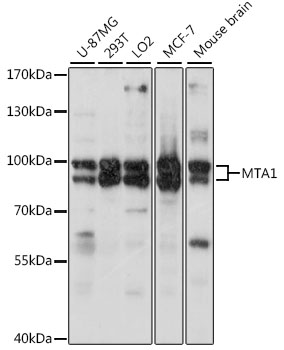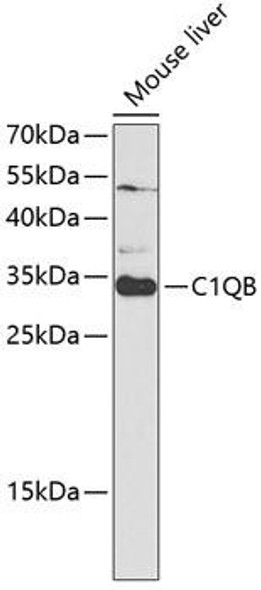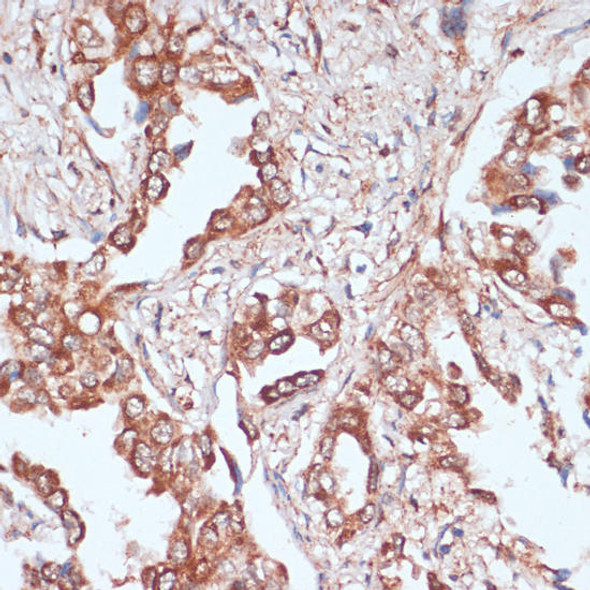Anti-MTA1 Antibody (CAB16085)
- SKU:
- CAB16085
- Product type:
- Antibody
- Reactivity:
- Human
- Mouse
- Host Species:
- Rabbit
- Isotype:
- IgG
- Antibody Type:
- Polyclonal Antibody
- Research Area:
- Cell Biology
Description
| Antibody Name: | Anti-MTA1 Antibody |
| Antibody SKU: | CAB16085 |
| Antibody Size: | 20uL, 50uL, 100uL |
| Application: | WB |
| Reactivity: | Human, Mouse |
| Host Species: | Rabbit |
| Immunogen: | A synthetic peptide corresponding to a sequence within amino acids 600-700 of human MTA1 (NP_004680.2). |
| Application: | WB |
| Recommended Dilution: | WB 1:500 - 1:2000 |
| Reactivity: | Human, Mouse |
| Positive Samples: | U-87MG, 293T, LO2, MCF-7, Mouse brain |
| Immunogen: | A synthetic peptide corresponding to a sequence within amino acids 600-700 of human MTA1 (NP_004680.2). |
| Purification Method: | Affinity purification |
| Storage Buffer: | Store at -20°C. Avoid freeze / thaw cycles. Buffer: PBS with 0.02% sodium azide, 50% glycerol, pH7.3. |
| Isotype: | IgG |
| Sequence: | LMPS RGLA NHGQ ARHM GPSR NLLL NGKS YPTK VRLI RGGS LPPV KRRR MNWI DAPD DVFY MATE ETRK IRKL LSSS ETKR AARR PYKP IALR QSQA LPPR P |
| Gene ID: | 9112 |
| Uniprot: | Q13330 |
| Cellular Location: | Cytoplasm, Nucleus, Nucleus envelope, cytoskeleton |
| Calculated MW: | 49kDa/79kDa/80kDa |
| Observed MW: | 81kDa, 90kDa |
| Synonyms: | MTA1 |
| Background: | This gene encodes a protein that was identified in a screen for genes expressed in metastatic cells, specifically, mammary adenocarcinoma cell lines. Expression of this gene has been correlated with the metastatic potential of at least two types of carcinomas although it is also expressed in many normal tissues. The role it plays in metastasis is unclear. It was initially thought to be the 70kD component of a nucleosome remodeling deacetylase complex, NuRD, but it is more likely that this component is a different but very similar protein. These two proteins are so closely related, though, that they share the same types of domains. These domains include two DNA binding domains, a dimerization domain, and a domain commonly found in proteins that methylate DNA. The profile and activity of this gene product suggest that it is involved in regulating transcription and that this may be accomplished by chromatin remodeling. Two transcript variants encoding different isoforms have been found for this gene. |
| UniProt Protein Function: | MTA1: metastasis-associated protein. A component of the NuRD ATP-dependent chromatin remodeling and histone deacetylase complex. Interacts with HDAC1. Expressed at high levels in metastatic cells. Two alternatively spliced isoforms have been described. The long isoform is a co-repressor of estrogen receptor (ER). The short isoform binds to ER and sequesters it in the cytoplasm and enhances non-genomic responses of ER. |
| UniProt Protein Details: | Protein type:Nuclear receptor co-regulator; Transcription, coactivator/corepressor; Motility/polarity/chemotaxis Chromosomal Location of Human Ortholog: 14q32.3 Cellular Component: cytoplasm; intracellular membrane-bound organelle; microtubule; nuclear envelope; nucleoplasm; nucleus; NuRD complex Molecular Function:chromatin binding; protein binding; transcription coactivator activity; transcription corepressor activity; transcription factor activity; zinc ion binding Biological Process: cellular protein metabolic process; circadian regulation of gene expression; double-strand break repair; entrainment of circadian clock by photoperiod; establishment and/or maintenance of chromatin architecture; locomotor rhythm; post-translational protein modification; proteasomal ubiquitin-dependent protein catabolic process; protein sumoylation; regulation of gene expression, epigenetic; regulation of inflammatory response; regulation of transcription, DNA-dependent; response to ionizing radiation; response to lipopolysaccharide; signal transduction; transcription, DNA-dependent |
| NCBI Summary: | This gene encodes a protein that was identified in a screen for genes expressed in metastatic cells, specifically, mammary adenocarcinoma cell lines. Expression of this gene has been correlated with the metastatic potential of at least two types of carcinomas although it is also expressed in many normal tissues. The role it plays in metastasis is unclear. It was initially thought to be the 70kD component of a nucleosome remodeling deacetylase complex, NuRD, but it is more likely that this component is a different but very similar protein. These two proteins are so closely related, though, that they share the same types of domains. These domains include two DNA binding domains, a dimerization domain, and a domain commonly found in proteins that methylate DNA. The profile and activity of this gene product suggest that it is involved in regulating transcription and that this may be accomplished by chromatin remodeling. Two transcript variants encoding different isoforms have been found for this gene. [provided by RefSeq, Feb 2011] |
| UniProt Code: | Q13330 |
| NCBI GenInfo Identifier: | 259016275 |
| NCBI Gene ID: | 9112 |
| NCBI Accession: | Q13330.2 |
| UniProt Secondary Accession: | Q13330,Q86SW2, Q8NFI8, Q96GI8, A5PLK4, |
| UniProt Related Accession: | Q13330 |
| Molecular Weight: | 79,192 Da |
| NCBI Full Name: | Metastasis-associated protein MTA1 |
| NCBI Synonym Full Names: | metastasis associated 1 |
| NCBI Official Symbol: | MTA1 |
| NCBI Protein Information: | metastasis-associated protein MTA1 |
| UniProt Protein Name: | Metastasis-associated protein MTA1 |
| Protein Family: | Mating type protein |
| UniProt Gene Name: | MTA1 |
| UniProt Entry Name: | MTA1_HUMAN |










